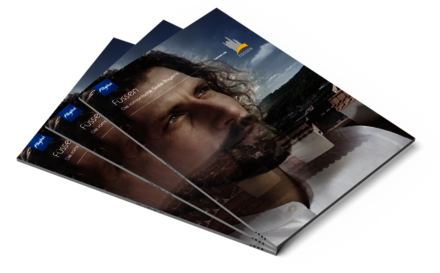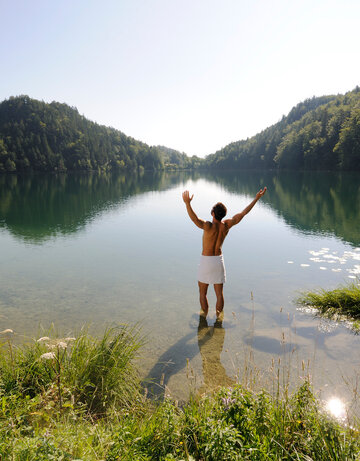Neuschwanstein Castle
A narrow mountain ridge to the left of the Pöllat called "Jugend" (Youth) appealed to King Ludwig II. He loved this place just as much as his father Maximilian II. The mountain-loving royal family hiked a lot in this area - you can also discover the area around Füssen on royal hikes. King Maximilian II had the Marienbrücke bridge built high above the Pöllat Gorge for his wife Marie to provide better access to the mountains. At that time, there were two castle ruins on the "Jugend": Vorder- and Hinterhohenschwangau. This is where Ludwig II planned his "New Hohenschwangau Castle", now known as Neuschwanstein Castle. He wanted to create an ideal of a medieval castle, equipped with the most modern technical achievements. The Wartburg with its Singers' Hall served as a model.
The foundation stone for the castle near Füssen was laid on September 5, 1869. Ludwig II hoped that construction would progress quickly, but the project was too extensive and the conditions on the mountain too difficult. The first thing to be completed in 1873 was the gatehouse, where the fairytale king lived on a daily basis. The topping-out ceremony did not take place until 1880 and the first rooms were occupied in 1884. Neuschwanstein Castle became the refuge of King Ludwig II. This castle in the Ostallgäu was his last place of residence before he was taken to Berg Castle on Lake Starnberg, where he died mysteriously shortly afterwards.
Visit
Today, Neuschwanstein Castle is a magnet for visitors from all over the world. From the Marienbrücke bridge, you not only have a unique view of the fairytale castle but also of the imposing Pöllat Gorge. The Museum of the Bavarian Kings is located directly on the Alpsee below Neuschwanstein Castle. It shows the history of the Wittelsbach dynasty and its Bavarian kings. Hohenschwangau Castle, where King Ludwig II spent part of his childhood, is also located directly in Hohenschwangau.
The castle can only be visited as part of a guided tour.
Tickets are availableonline at the Ticket Center Hohenschwangau . Please book your tickets in good time!
Neuschwanstein Castle can be reached from Hohenschwangau on foot, by horse-drawn carriage or by shuttle bus.

Information about the castles
You can find comprehensive information about visiting the royal castles of Neuschwanstein and Hohenschwangau in our "Castle information" flyer.
Neuschwanstein Castle is open:
- April 1 to October 15: daily from 9 a.m. to 6 p.m.
- October 16 to March 31: daily from 10.00 a.m. to 4.00 p.m.
Closing days: 24.12.24, 25.12.24, 31.12.24, 01.01.25
Tickets are available online and at the Hohenschwangau Ticket Center (limited daily quota).
Visits are only possible as part of a guided tour!
- Regular ticket 21,00 EUR
- Reduced price 20.00 EUR(information on discounts)
- Children (0-17 years) free of charge
- Information on combined tickets(with Hohenschwangau Palace and/or the Museum of the Bavarian Kings)
The ticket prices do not include an advance booking or handling fee of EUR 2.50.
- By public transportation: Bus routes 73 and 78 run from Füssen railroad station to Hohenschwangau. Please note that the buses can be very full, especially in the summer months between July and September. Although additional buses are operated, delays can still occur. We recommend that rail travelers allow a sufficient buffer between the bus and train journey.
- On foot or by bike: The shortest route from the Tourist Information Füssen to the Ticket Center in Hohenschwangau is 3.8 kilometers. The paved footpath or cycle path runs parallel to the road connection between Füssen and Hohenschwangau. Alternatively, there is a very beautiful hiking route via the Alpenrosenweg to Hohenschwangau (approx. 2 hours). Signposted footpaths lead from the Ticket Center in Hohenschwangau to Neuschwanstein Castle.
- From Hohenschwangau by horse-drawn carriage or bus: You can also cover the route from the Ticket Center to Neuschwanstein Castle by horse-drawn carriage or bus. In both cases, the last section of the route to the castle must be covered on foot (approx. 15 minutes). The following prices apply for the transfer to the castle: Horse-drawn carriage: ascent: 8.00 EUR / descent 4.00 EUR; Bus: ascent: 3.50 EUR / descent 3.50 EUR / ascent and descent 5.00 EUR
By car: Leave Füssen via Bundestraße 16 in the direction of Schwangau. After the Lech bridge, turn right at the second intersection towards Hohenschwangau and follow the road to the signposted parking lots. Please note that the road to Neuschwanstein Castle is marked as "Königsschlösser" on the road signs. We strongly recommend that you park your vehicle in one of the paid parking lots. Parking is prohibited on the roads near the castles. The official parking lots cost between 12.00 and 16.00 EUR per day for cars.
Please note: Allow at least 1.5 hours to get from the ticket center to the castle!
It is generally possible to visit Neuschwanstein Castle with reduced mobility. A regular tour of Neuschwanstein Castle involves climbing a total of around 300 steps. Visitors with reduced mobility can still visit the castle. Special guided tours with use of the castle's own elevator are available on request. However, it is essential to book in advance. If you have limited mobility, please contact the Ticket Center in Hohenschwangau in advance
(Telephone: +49 8362 9308-30 or e-mail: info(at)ticket-center-hohenschwangau.de).
Photography around the royal palaces is permitted for private purposes.
Indoor photography is prohibited.
More details about Neuschwanstein Castle with all FAQs can be found at the Bavarian Palace Administration and the Ticket-Center Hohenschwangau.
Contact Ticket-Center:
Phone: +49 8362 9308-30
E-mail: info(at)ticket-center-hohenschwangau.de
Leaflets and flyers
View, download or order brochures, local maps and leaflets.










